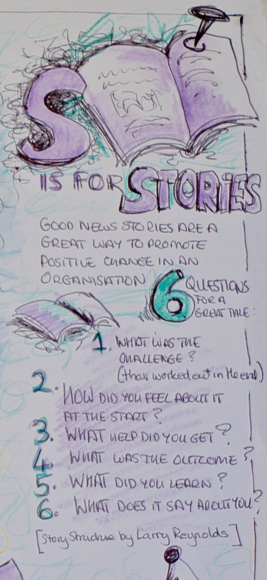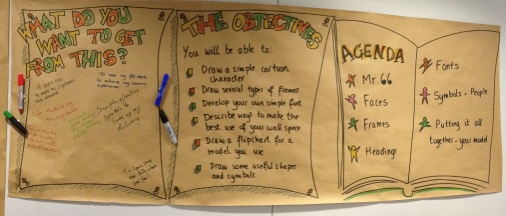This is the 5th in my series of 5 easy brain tips for engaging learners from my session at the CIPD NAP conference in June 2015. The 5 brain tips can be remembered using the mnenomic CRUMMSS:
- C – choice – last weeks blog
- R – Rewards – this weeks blog
- UM – Use metaphors
- MS – Microskills
- S – stories
When we tell stories our brains react not only through the traditional language areas in the brain (Brocas and Wernickes areas) but  also in those regions related to the story.
also in those regions related to the story.
So if the storyteller speaks about baking and aromas, then those regions in the brain related to smell will be engaged. In this way the storyteller can almost plant ideas, thoughts and emotions in the listeners brain by using expressive language.
This work was carried out by a team of scentists at Princeton1, led by Uri Hasson where they observed MRI scans of the listeners and the storytellers brains. They found that the brain activities matched, showing the power of storytelling.
By using positive stories through an organisation, we can influence people to believe it is possible that change can take place and it will give them the same feel good factor that others have felt, even if they have not yet experienced it.
These are the 6 questions you can answer in order to come up with a well-structured story:
- What was the challenge (that worked out in the end?)
- How did you feel about it at the start?
- What help did you get?
- What was the outcome?
- What did you learn?
- What does it say about you?
(Story structure by Larry Reynolds)
Stories can also be used to “prime” people prior to an event. For example before a change programme, tell stories of how other organisations and individuals have come through similar changes with positive outcomes. Prior to a training event let others tell their stories about their experience on the course (a good one!)
- David Rock “Your Brain at Work”, Harper Business 2009





 UM is for “Use Metaphor“. Emotions can run high during any change programme and a workshop can easily turn it into a whinge-fest. Allow people time to express their emotions using metaphors and limit the time for the whingeing.
UM is for “Use Metaphor“. Emotions can run high during any change programme and a workshop can easily turn it into a whinge-fest. Allow people time to express their emotions using metaphors and limit the time for the whingeing.


 Recent research from the CIPD(
Recent research from the CIPD(

 You may know that it is the prefrontal cortex that is key to new learning, but when our limbic (emotional) systems get over aroused, we suffer from a lack of prefrontal cortex function.
You may know that it is the prefrontal cortex that is key to new learning, but when our limbic (emotional) systems get over aroused, we suffer from a lack of prefrontal cortex function. I love to be creative and even though the third paper in the CIPD series, is entitled “Insight and Intuition”, it does a lot to help explain what creativity is about. It looks at how insight leads to ideation and in turn innovation, whilst considering how both skills can boost creativity and problem solving. It also considers what can block creativity and which tools can help. All in all a helpful paper so lets get stuck into the meaty bits…..
I love to be creative and even though the third paper in the CIPD series, is entitled “Insight and Intuition”, it does a lot to help explain what creativity is about. It looks at how insight leads to ideation and in turn innovation, whilst considering how both skills can boost creativity and problem solving. It also considers what can block creativity and which tools can help. All in all a helpful paper so lets get stuck into the meaty bits…..
 Well the plot thickens…….. this gaming lark I mentioned in my last blog….. why it works…….it is all about synaptic plasticity …..so the researchers think!
Well the plot thickens…….. this gaming lark I mentioned in my last blog….. why it works…….it is all about synaptic plasticity …..so the researchers think!
 John Medina, in his 10 Brain Rules states “Vision trumps all other senses” and
John Medina, in his 10 Brain Rules states “Vision trumps all other senses” and 


You must be logged in to post a comment.